Marrying Vega and Zen: The AMD Ryzen 5 2400G Review
by Ian Cutress on February 12, 2018 9:00 AM ESTBenchmarking Performance: CPU Office Tests
The office programs we use for benchmarking aren't specific programs per-se, but industry standard tests that hold weight with professionals. The goal of these tests is to use an array of software and techniques that a typical office user might encounter, such as video conferencing, document editing, architectural modelling, and so on and so forth.
All of our benchmark results can also be found in our benchmark engine, Bench.
Chromium Compile (v56)
Our new compilation test uses Windows 10 Pro, VS Community 2015.3 with the Win10 SDK to combile a nightly build of Chromium. We've fixed the test for a build in late March 2017, and we run a fresh full compile in our test. Compilation is the typical example given of a variable threaded workload - some of the compile and linking is linear, whereas other parts are multithreaded.
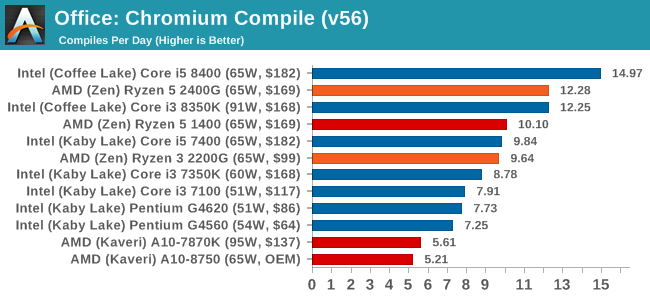
Our compile test has an eclectic mix of requirements, with different segments having different bottlenecks. The Ryzen 5 2400G matches the higher frequency of the Core i3-8350K, even though it already has a core and memory advantage. An interesting thing here is that the Ryzen 3 2200G and the Ryzen 5 1400 are almost evenly matched, even though the 1400 has double the threads. This is because of the frequency of the 2200G, and the memory speed.
PCMark 10
PCMark 10 is the latest all-in-one office-related performance tool that combines a number of tests for low-to-mid office workloads, including some gaming, but focusing on aspects like document manipulation, response, and video conferencing.

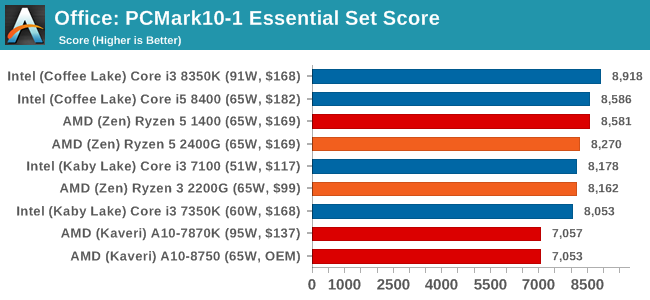
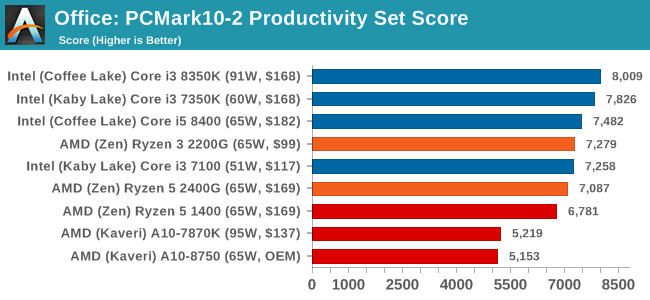
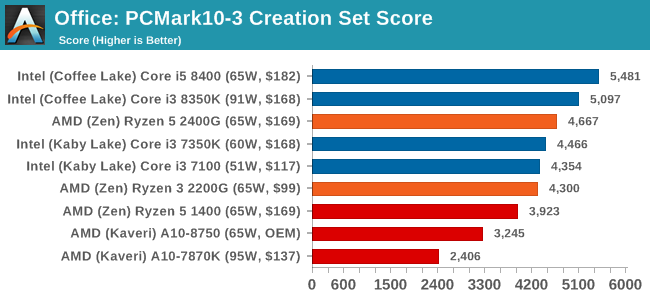
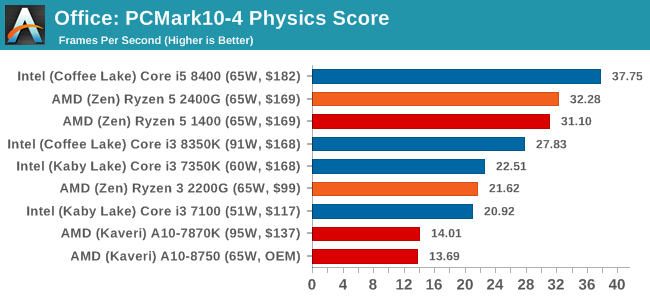
PCMark8: link
Despite originally coming out in 2008/2009, Futuremark has maintained PCMark8 to remain relevant in 2017. On the scale of complicated tasks, PCMark focuses more on the low-to-mid range of professional workloads, making it a good indicator for what people consider 'office' work. We run the benchmark from the commandline in 'conventional' mode, meaning C++ over OpenCL, to remove the graphics card from the equation and focus purely on the CPU. PCMark8 offers Home, Work and Creative workloads, with some software tests shared and others unique to each benchmark set.
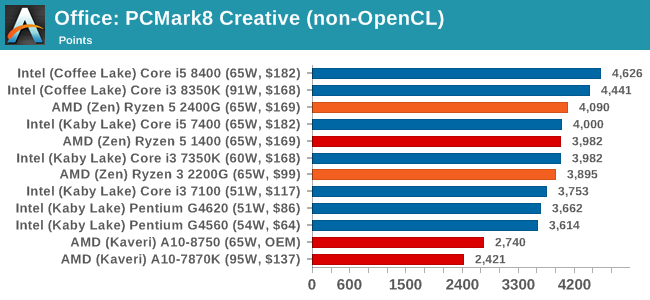
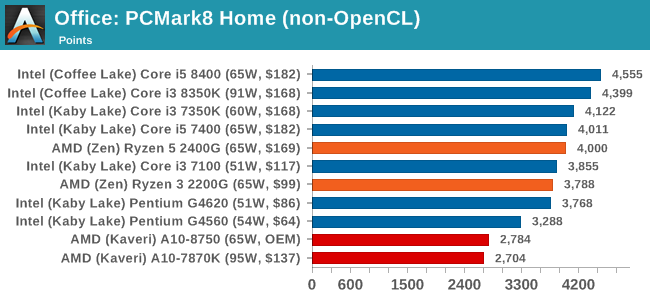
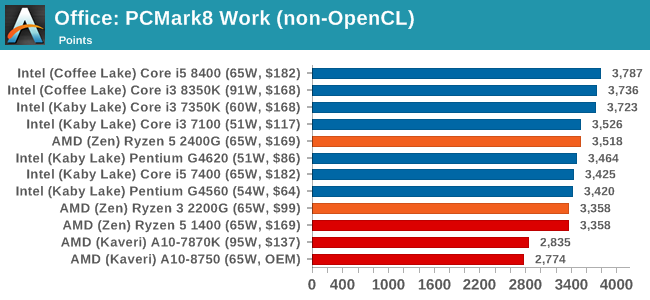










177 Comments
View All Comments
nevcairiel - Tuesday, February 13, 2018 - link
Some more realistic gaming settings might be nice. Noone is going to play on settings that result in ~20 fps, and the GPU/CPU scaling can tilt quite a bit if you reduce the settings.I can see why you might not like it, because it takes the focus away from the GPU a bit and makes comparisons against a dGPU harder (unless you run it on the exact same hardware, which might mean you have to re-run it every time), but this is a combined product, so testing both against other iGPU products would be useful info.
atatassault - Tuesday, February 13, 2018 - link
20 FPS is playable. I have a 2 in 1 with a Skylake i3-6100u, and 20 FPS is what it gets in Skyrim. Any notion of things being "unplayable" under 30/60 FPS is like an audiohile saying songs are unlistenable on speakers less than $10,000.lmcd - Tuesday, February 13, 2018 - link
Any notion of things being "unplayable" under 30/60 FPS is like an audiophile saying songs are unlistenable on speakers less than $100.Fixed it for you (FIFY).
nevcairiel - Thursday, February 15, 2018 - link
I rather reduce settings a bit to go up in FPS then look at 20 fps average. There often is many things one can turn off without a huge visual impact to achieve much better performance.29a - Saturday, October 26, 2019 - link
What a useless review. I came here to see if this thing can do some low end gaming and you didn't even test on 720p.Gideon - Tuesday, February 13, 2018 - link
Yes sorry, I didn't mean to nitpick. Just being a web developer myself dealing mosrly with frontend code, I just wanted to mention that Speedometer is actually considered to be fairly representative by both Mozilla and Google (and true enough the frameworks they use are actual frontend JS frameworks rendering TodoMVC) If you are already aware of that then that's excellent.richardginn - Monday, February 12, 2018 - link
An article looking at how memory speed affects FPS on the 2400G and 2200G is s must.I say you can 1080P game with this although it looks like for a bunch of games you will be on low settings
stanleyipkiss - Monday, February 12, 2018 - link
Check out Hardware Unboxed's review on YouTube. They did just that.beginner99 - Tuesday, February 13, 2018 - link
Yeah this review should have used medium or low settings, something that is actually playable on the CPUs tested. 25 fps might work for Civ6 but not a shooter.iter - Monday, February 12, 2018 - link
Not too shabby, 2-3x the igpu perf of intel and comparable cpu perf in the same price range. And it will likely pull ahead even further in the upcoming weeks as faster memory becomes supported.